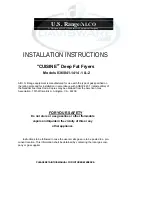
45 SERIES GAS FRYERS
CHAPTER 2: INSTALLATION INSTRUCTIONS
2-1
2.1
General Installation
Requirements
PROPER INSTALLATION IS ESSENTIAL FOR
EFFICIENT, TROUBLE-FREE OPERATION OF
YOUR FRYER. ANY UNAUTHORIZED AL-
TERATIONS MADE TO THIS EQUIPMENT WILL
VOID THE
FRYMASTER
WARRANTY.
Upon arrival, inspect the fryer carefully for
visible or concealed damage. (See
Shipping
Damage Claim Procedure
in Chapter 1.)
CLEARANCE AND VENTILATION
The fryer(s) must be installed with a 6” (150
mm) clearance at both sides and back when
installed adjacent to combustible construction;
no clearance is required when installed adja-
cent to noncombustible construction. A
minimum of 24” (600 mm) clearance should
be provided at the front of the fryer.
One of the most important considerations of
efficient fryer operation is ventilation. Make
sure the fryer is installed so that products of
combustion are removed efficiently, and that
the kitchen ventilation system does not pro-
duce drafts that interfere with proper burner
operation.
The fryer flue opening must not be placed
close to the intake of the exhaust fan, and the
fryer must never have its flue extended in a
“chimney” fashion. An extended flue will
change the combustion characteristics of the
fryer, causing longer recovery time. It also
frequently causes delayed ignition. To pro-
vide the air flow necessary for good combus-
tion and burner operation, the areas surround-
ing the fryer front, sides, and rear must be kept
clear and unobstructed.
Fryers must be installed in an area with an
adequate air supply and adequate ventilation.
Adequate distances must be maintained from
the flue outlet of the fryer to the lower edge of
the ventilation filter bank. Filters should be
installed at an angle of 45º. Place a drip tray
beneath the lowest edge of the filter. For U.S.
installation, NFPA standard No. 96 states, “A
minimum distance of 18 in. (450 mm) should
be maintained between the flue outlet and the
lower edge of the grease filter.” Frymaster
recommends that the minimum distance be 24
in. (600 mm) from the flue outlet to the bottom
edge of the filter when the appliance consumes
more than 120,000 BTU per hour
.
Information on construction and installation of
ventilating hoods can be found in the NFPA
standard cited above. A copy of the standard
may be obtained from the National Fire Pro-
tection Association, Battery March Park,
Quincy, MA 02269.
DANGER
Do not attach an apron drainboard to a
single fryer. The fryer may become
unstable, tip over, and cause injury.
The appliance area must be kept free
and clear of combustible materials at
all times.
NATIONAL CODE REQUIREMENTS
The type of gas for which the fryer is equipped
is stamped on the data plate attached to the
inside of the fryer door. Connect a fryer
stamped “NAT” only to natural gas, those
stamped “PRO” only to propane gas, and
those stamped “MFG” only to manufactured
gas.
Installation shall be made with a gas connector
that complies with national and local codes,
and, where applicable, CE codes. Quick-
Disconnect devices, if used, shall likewise










































